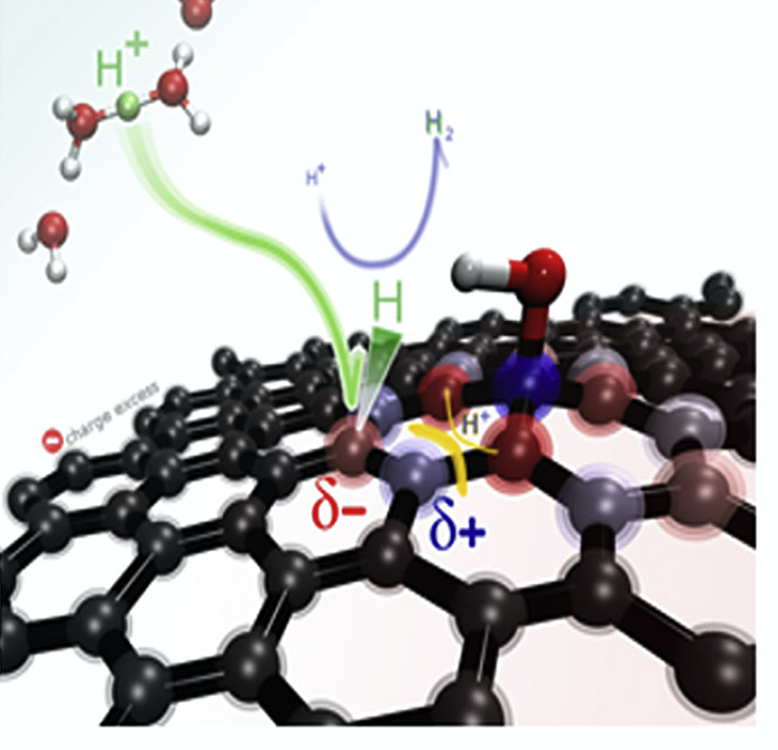V. Tozzini, L. Bellucci, C. Cardoso, D. Prezzi, C. A. Rozzi, S. Pittalis, D. Varsano, A. Ferretti, R. Nifosì, R. Farchioni.

Through multi-scale simulations including combinations of ab initio calculations (DFT based) and classical molecular dynamics and low resolution models with advanced sampling techniques, Cnr Nano deals with the study of the structural and chemical properties of low-dimensional materials both in epitaxial and nanoporous bulk form, addressing their reactivity and functionalization as elements of super-capacitors, batteries or other devices for filtering, extraction and storage of energy or hydrogen.
Advanced simulation of electronic and optical spectroscopies are also used in the study of prototype interfaces and complex supramolecular systems, including the effects of environment (solvent or contact with other dielectrics) and coupling with ions. An accurate description of the electronic and optical properties, such as the accurate line-up determination of energy levels or excitonic states of complex interfaces and / or interphase materials, as well as the inclusion of vibronic effects or relaxation in the excited state, is crucial for the description and optimization of the microscopic properties of materials that operate – even under realistic electrochemical conditions – in batteries and other energy conversion (photovoltaic systems) , photocatalytic and storage devices.
Selected Publications
Intermolecular conical intersections in molecular aggregates,
A. De Sio, E. Sommer, X.T. Nguyen, L. Gross, D. Popovic, B.T. Nebgen, S. Fernandez-Alberti, S. Pittalis, C.A. Rozzi, E. Molinari, E. Mena-Osteritz, P. Bauerle, T. Frauenheim, S. Tretiak, and C. Lienau,
Nat Nanotechnol 16, 63-68 (2021); doi: 10.1038/s41565-020-00791-2
Optical Properties of Lead-Free Double Perovskites by Ab Initio Excited-State Methods,
M. Palummo, E. Berrios, D. Varsano, and G. Giorgi,
ACS Energy Lett. 5, 457-463 (2020); doi: 10.1021/acsenergylett.9b02593
Water splitting for hydrogen chemisorbed in graphene oxide dynamically evolves into a graphane lattice,
L. Ciammaruchi, L. Bellucci, G. Comerón Castillo, G. Martínez-Denegri Sánchez, Q. Liu, V. Tozzini, and J. Martorell,
Carbon 153, 234-241 (2019); doi: 10.1016/j.carbon.2019.06.087
Engineering 3D Graphene-Based Materials: State of the Art and Perspectives,
L. Bellucci and V. Tozzini,
Molecules 25 (2), 339 (2020); doi: 10.3390/molecules25020339
Electronic and optical properties of doped TiO2 by many-body perturbation theory,
M. O. Atambo, D. Varsano, A. Ferretti, S. S. Ataei, M.J. Caldas, E. Molinari, and A. Selloni,
Phys. Rev. Mat. 3, 045401 (2019); doi: 10.1103/PhysRevMaterials.3.045401
Tailoring optical properties and stimulated emission in nanostructured polythiophene,
A. Portone, L. Ganzer, F. Branchi, R. Ramos, M.J. Caldas, D. Pisignano, E. Molinari, G. Cerullo, L. Persano, D. Prezzi, and T. Virgili,
Scientific Reports 9, 7370 (2019); doi: 10.1038/s41598-019-43719-0

